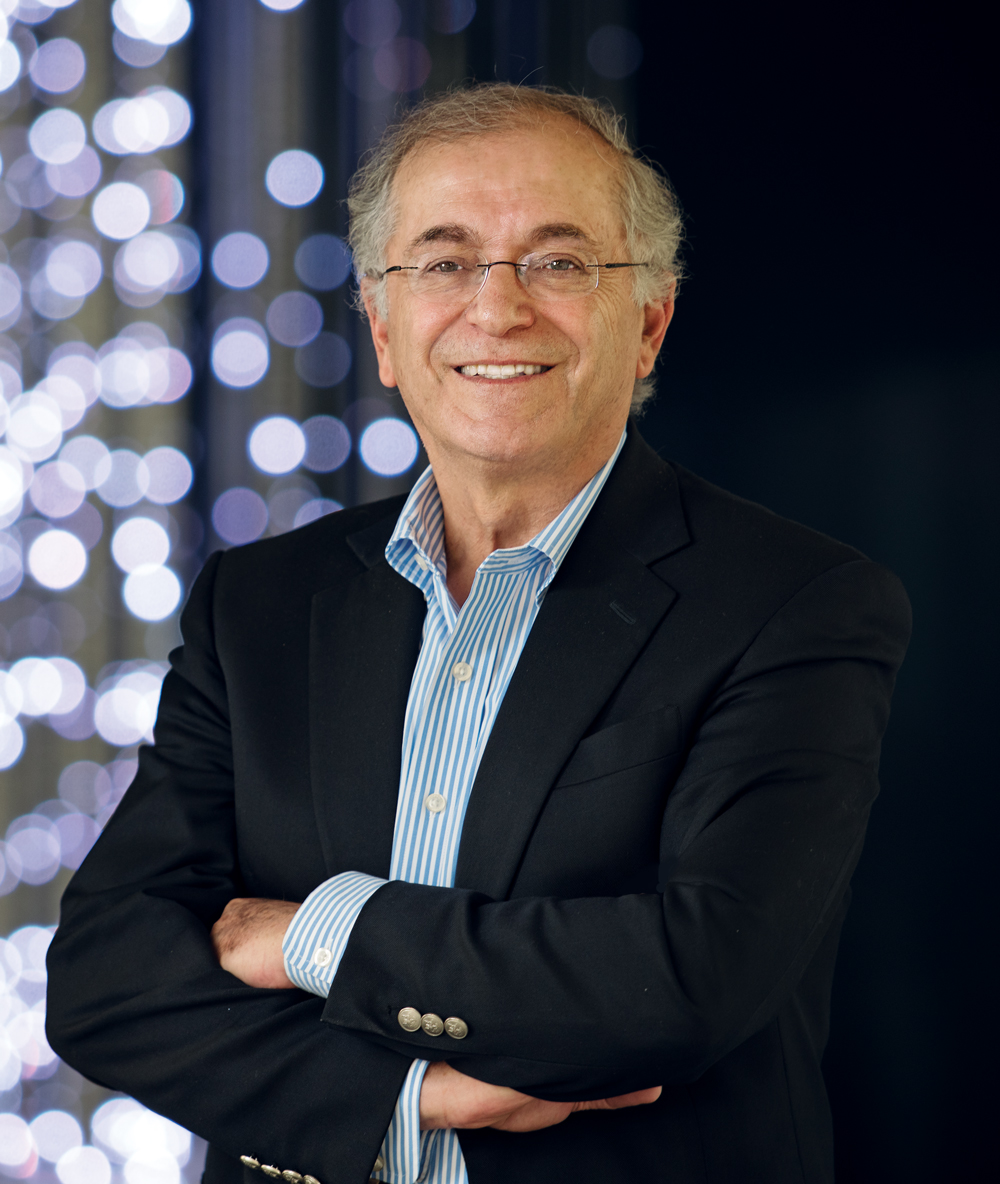2016 PRESS/PHOTO INFORMATION
Press Release
RNASA Foundation Honors Dr. Charles Elachi, Bill Nye, and Stellar Winners
Rotary National Award for Space Achievement
May 3, 2016
Media Contact: Lindsey Cousins, 281-723-5683, lindsey@baysidegraphics.net
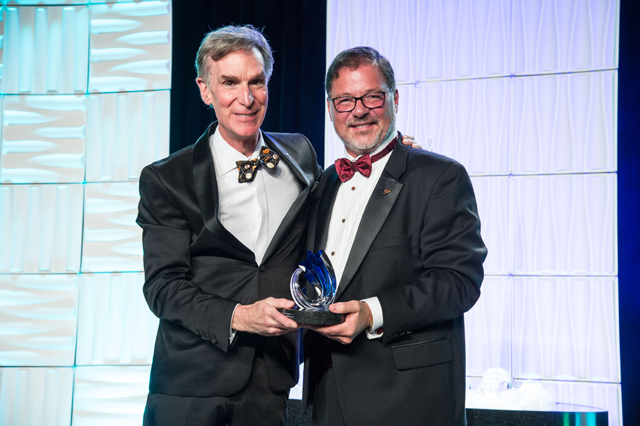
Download high resolution.
Elliot Pulham, CEO of the Space Foundation presents the Space Communicator Award to Bill Nye (NASA Photo, 2016)
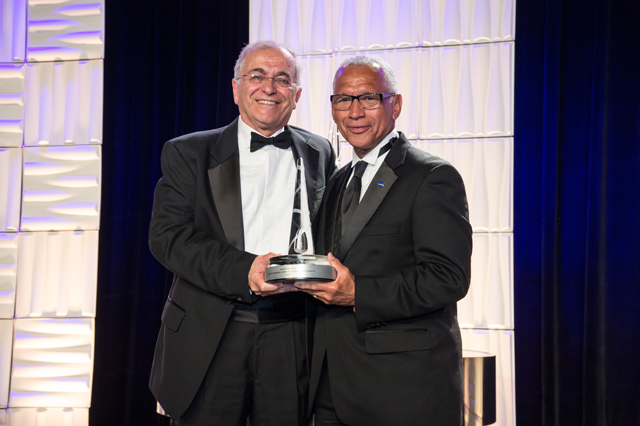
Download high resolution.
NASA Administrator Gen. Charles Bolden presents the National Space Trophy to JPL Center Director, Dr. Charles Elachi (NASA Photo, 2016)
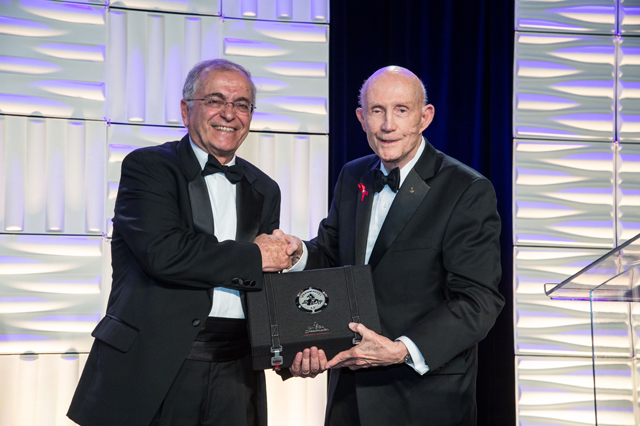
Download high resolution.
Lt. Gen. Thomas Stafford presents the OMEGA speedmaster watch to Dr. Charles Elachi (NASA Photo, 2016)
After the ceremonies opened with "The Soul of the Explorer", a short film by Space City Films, RNASA Foundation Chairman Rodolfo González welcomed the guests to gala, saying that "RNASA's mission is to encourage, recognize, honor and celebrate U.S. space achievements from across the entire country and across all sectors."
The Clear Lake High School Clear Lake High School JROTC Color Guard presented the colors, followed by Reagan Johnson, who sang the National Anthem. Reverend William H. King, III, Greater New Hope Missionary Baptist Church, gave the invocation. Rodolfo González recognized the former NST winners in attendance: Col. Robert Cabana, Gen. Charles Bolden, Capt. Michael Coats, Bill Gerstenmaier, Dr. Michael Griffin, Col. Eileen Collins, Dr. Glynn Lunney, Tommy Holloway, and Lt. Gen. Thomas Stafford. U.S. congressman John Culberson, representing the Texas 7th district was also in attendance and recognized.
After dinner, the program kicked off with a year-in-review film by Space City Films. Miles O'Brien, former CNN correspondent and current science correspondent for PBSNewsHour served as the emcee.
American political satirist and author, P.J. O'Rourke had the crowd laughing as the evenings' featured speaker.
Elliot Pulham, Space Foundation CEO presented the 2016 Space Communicator Award to Bill Nye, CEO of the Planetary Society and best known for his role as Bill Nye the Science Guy.
The Stellar Award winners were announced by NASA Astronaut Rex Walheim, STS-110, STS-122 and STS-135 and NASA Astronaut Stephanie Wilson, STS-121, STS-120 and STS-131 who then presented them with engraved marble trophies donated by Orbital ATK. The Stellar Awards were presented in Early Career, Mid-Career, Late Career, and Team categories.
Charles Bolden, NASA Administrator and recipient of the 2014 National Space Trophy, presented the prestigious 2016 National Space Trophy to Dr. Charles Elachi. NASA Astronaut Tim Kopra sent a message down from the International Space Station praising the work of the Jet Propulsion Laboratory and congratulating Dr. Elachi on receiving the National Space Trophy. To further commemorate the 30th annual event, the giant 500-pound National Space Trophy housed at Space Center Houston was also on display on center stage.
Lt. Gen Thomas P. Stafford, USAF (Ret.), Gemini and Apollo astronaut, and the 1993 National Space Trophy winner, presented an OMEGA watch to Elachi.
TASC donated the portrait of Elachi by Pat Rawlings, which was on display at the gala and used as the cover of the souvenir program. The portrait will become part of the National Space Trophy display at Space Center Houston for one year.
RNASA Chairman Rodolfo González concluded the evening by thanking the Foundation's corporate sponsors whose support and achievements made the event possible: a.i.solutions, Inc., Aerojet Rocketdyne, The Aerospace Corp , ARES Corporation, ASRC Federal, Barrios Technology, Bastion Technologies, Inc., The Boeing Company, Booz Allen Hamilton, CACI International, Caltech/JPL, Cimarron, DB Consulting Group, Inc., ERC, Inc., GeoControl System, Inc., Honeywell, Jacobs, Lockheed Martin, MEI Technologies, Inc., MORI Associates, Inc., MRI Technologies , Oceaneering International, Inc., Orbital ATK, Raytheon, SAIC, SGT, Inc., Sierra Nevada Corporation, Space Foundation, SpaceX, TASC, University of Houston-Clear Lake, UTC Aerospace Systems, and Wyle.
Visit http://www.rnasa.org/photos.html for images from the event.
The RNASA Space Awards black tie Gala on April 29, 2016, was recorded live, in its entirety, by Space City Films and will air on NASA TV on Tuesday, May 3rd, and Wednesday, May 4th at noon and 7 pm CDT. NASA TV is carried by DirecTV, Dish Network, TVRO, several cable providers, and http://www.nasa.gov/multimedia/nasatv/ustream/.
About RNASA: The Rotary National Award for Space Achievement (RNASA) Foundation was founded by the Space Center Rotary Club of Houston, Texas in 1985 to organize and coordinate an annual event to recognize outstanding achievements in space and create greater public awareness of the benefits of space exploration. The nonprofit Foundation presents the National Space Trophy and Stellar Awards each year. See http://www.rnasa.org for more information.
Read the press release as a Word document.
Press Release
RNASA's 2016 Stellar Awards Winners Announced
Rotary National Award for Space Achievement
May 3, 2016
Media Contact: Lindsey Cousins, 281-723-5683, lindsey@baysidegraphics.net
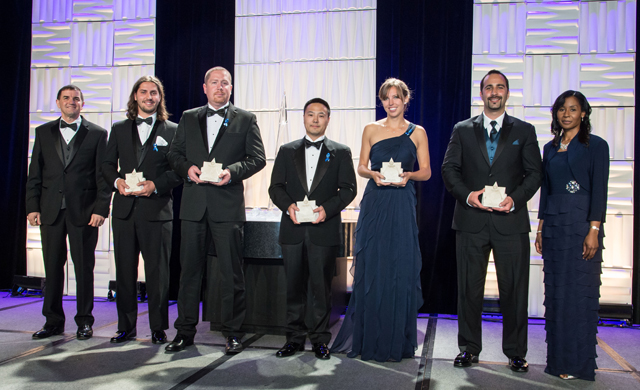
Download high resolution.
L to R: Rex Walheim (presenting), Kiril Dontchev, Dr. Brien Flewelling, Alan Kim, Sarah Baldwin, Anthony Cook, Stephanie Wilson (presenting). Not Pictured: Cora Traecy (NASA photo, 2016)
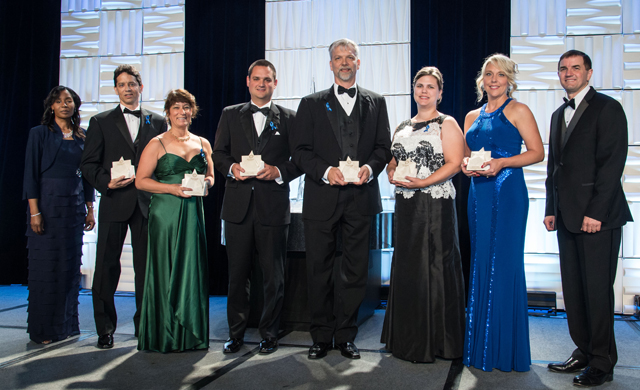
Download high resolution.
L to R: Stephanie Wilson (presenting), Paul Connolly, Lorraine Prokop, Anthony DiCello, Bruce Sommer, Leslie Robertson, Shelia Sharp, Rex Walheim (presenting). Not Pictured: Judith Blackwell-Thompson, Lt. Col. Christian Elenbaum (NASA photo, 2016)
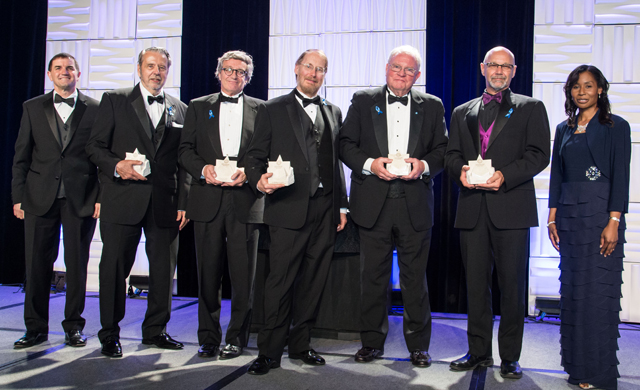
Download high resolution.
L to R: Rex Walheim (presenting), George Dickey Arndt, Laurence Price, Dr. Geoffrey Landis, Mark Craig, Robert Brazier, Stephanie Wilson (presenting) (NASA photo, 2016)
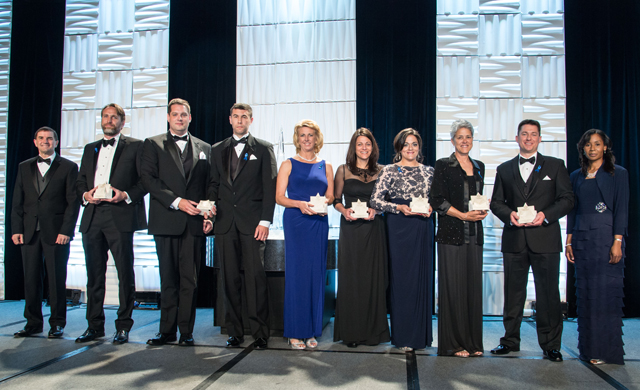
Download high resolution.
L to R: Rex Walheim (presenting), Andrew Zarechnak (OA-4 Return to Flight Team of Orbital ATK), Seth Lacy, Corey Duncan (Automated Navigation and Guidance Experiment for Local Space Program Team), Debbie Sharp (ISS Hardware Recovery Team), Carolyn Gernux (Fan/Pump/Separator Bearing Corrosion Anomaly Resolution Team), Yasmin Ali (Pendulum Team), Janine Cuevas (EFT-1/Orion Aerojet Rocketdyne Propulsion Team), Brian Jones (Orion EM-1 Critical Design Review Team), Stephanie Wilson (presenting) (NASA photo, 2016)
Every year, the aerospace community anxiously awaits the announcement of the Rotary National Award for Space Achievement (RNASA) Stellar Award winners.
The 2016 Stellar Awards Evaluation Panel, Dr. Glynn Lunney, Arnold Aldrich, Colonel Eileen Collins, and Michael Coats selected the winners based on which accomplishments have advanced U.S. space capabilities and hold the greatest promise of future capabilities.
Out of 137 nominations received, the Panel selected 19 individuals and 7 teams for recognition.
Prior to the evening's festivities, all nominees were treated to a behind-the-scenes tour of the Johnson Space Center and a luncheon at South Shore Harbour Resort. Stellar Awards Committee Chair Jennifer Devolites welcomed the nominees and then said, "You are here because you are excellent." She asked the nominees to consider using their excellence to provide leadership to others, take on mentoring, and to also take risks and get outside of their comfort zones with regard to what they already do well.
Captain Sunita Williams was the featured speaker at the Stellar Awards Luncheon. Launched on STS-116 in December 2006, Williams joined the Expedition 14 crew onboard the International Space Station. She completed three spacewalks in 2007, setting a new record for spacewalk time by a woman that stood until December 2008. Upon landing in June 2007, she had spent a record-breaking 194 days, 18 hours and 58 minutes in space.
Each nominee received a Fisher Space Pen donated by the company. The Fisher Space Pen was originally carried by the astronauts of the Apollo moon missions and is still used on manned space flights to this day. They are precision assembled, hand tested, and guaranteed to perform underwater, at any angle including upside down, in extreme temperatures, and of course in zero gravity.
All the Stellar nominees had their photo taken as they received a special commemorative certificate with a United States flag that was flown aboard the Space Shuttle Endeavour, STS-108, December 5 - 17, 2001.
The Stellar Award winners were announced at the RNASA evening gala on April 29, 2016 by Astronaut Rex Walheim and Astronaut Stephanie Wilson who presented them with engraved marble trophies donated by Orbital ATK. The winners in each of the four categories, Early Career, Mid Career, Late Career and Team are:
2016 Stellar Award Winners in the Early Career Category
Sarah Baldwin of Aerojet Rocketdyne - Outstanding leadership, technical excellence, and innovation in flight operations contributing to the 100% mission success of the rs-68 rocket engine.
Alan Kim of The Boeing Company - Engineering excellence in solving difficult stress analysis challenges for SLS.
Dr. Brien Flewelling of the U.S. Air Force Research Laboratory - Outstanding contributions to image processing and computer vision applied to advanced space object detection, tracking, identification, and characterization.
Cora Treacy of UTC Aerospace Systems - Outstanding management effectiveness in support of the eatcs, eclss and regenerative eclss on-board the international space station.
Kiril Dontchev of SpaceX - Recognized for exceptional leadership overseeing the pad abort test of the crew dragon spacecraft's integrated launch abort system.
Anthony Cook of The Boeing Company - Outstanding leadership and technical contributions to development, implementation, and delivery of new iss nitrogen/oxygen resupply system compatible with multiple launch systems
2016 Stellar Award Winners in the Mid-Career Category
Leslie Robertson of The Boeing Company - Outstanding technical knowledge and ingenuity in development and deployment of compiler, patch and review tools for the iss program, including training and support across iss software development teams.
Bruce Sommer of Lockheed Martin - Outstanding human spaceflight contributions for improving iss and orion mpcv crew safety and ensuring mission success.
Judith Blackwell-Thompson of NASA Kennedy Space Center - Exemplary leadership and sustained contributions to manned space flight launch planning and execution.
Anthony Dicello of The Boeing Company - Exceptional leadership contributions of the development of the first two international docking adapters which will adapt the international space station for docking by the next generation of commercial crew transportation systems.
Lorraine Prokop of NASA Johnson Space Center - Pioneering contributions to aerospace software engineering, including significant advances in human spaceflight software affordability.
Paul Connolly of Pratt & Whitney - Outstanding contributions to understanding the ORSC cycle and its operation in the rd-180 rocket engine.
Lt. Col. Christian Elenbaum of U.S. Air Force - Exceptional contributions to space based infrared systems program reducing satellite production costs over one billion dollars.
Sheila Sharp of The Boeing Company - Outstanding accomplishments in the leadership, mentorship and development of critical teams in the definition, design and integration of program requirements and resolution resulting in program progress, compliance and overall performance.
2016 Stellar Award Winners in the Late Career Category
Mark Craig of SAIC - Outstanding career of service to nasa dedicated to improving the value of human space exploration spanning apollo, space shuttle, space station and beyond.
Dr. Geoffrey Landis of NASA Glenn Research Center - Exceptional technical achievements and leadership in developing photovoltaic power systems and advanced concepts in support of NASA missions.
Lawrence Price of Lockheed Martin - Outstanding leadership and international collaboration to take the orion program from development to space flight vehicles for NASA's human exploration missions.
George Dickey Arndt of NASA Johnson Space Center - Outstanding dedication to exceptional electromagnetic technology development utilizing collaborations from within and outside the agency.
Robert Brazier of Aerojet Rocketdyne - Invaluable contributions and leadership in the production of liquid rocket propulsion in support of the advancement of America's space programs.
Stellar Award Winners - Team
EFT-1/Orion Propulsion Team of Aerojet Rocketdyne - Outstanding team dedication and attention to detail during development, production, flight readiness, and flight, resulting in significant achievement on orion eft-1 and paving the way for advanced future space activities. Award accepted by Janine Cuevas.
Pendulum Team of NASA Johnson Space Center - Outstanding team effort in mitigating the orion pendulum motion anomaly. Award accepted by Yasmin Ali.
Fan/Pump/Separator Bearing Corrosion Anomaly Resolution Team of UTC Aerospace Systems - Outstanding achievement in preparation for and execution of a contingency eva to eliminate an ammonia leak that jepordized the international space station. Award accepted by Carolyn Gernux.
International Space Station Hardware Recovery Team for Launch on HTV-5 of The Boeing Company - Quickly accelerating manufacture and test of hardware, and rebuilding several critical hardware items for on-time delivery to meet the htv-5 launch, support on-orbit operations, and support crew health and safety. Award accepted by Debbie Sharp.
Automated Navigation and Guidance Experiment for Local Space (Angels) Program Team of U.S. Air Force Research Laboratory - Outstanding team achievement in evolving the air force's ability to responsively perform space situation awareness missions. Award accepted by Corey Duncan.
OA-4 Return to Flight Team of Orbital ATK - Outstanding technical and management excellence in providing timely reinstatement of cygnus cargo resupply services to the iss. Award accepted by Andrew Zarechnak.
Orion EM-1 Critical Design Review Team of Lockheed Martin - Excellence in preparation, execution and follow through of the orion exploration mission critical design review that resulted in nasa's authorization to proceed to spacecraft production. Award accepted by Brian Jones.
Visit http://www.rnasa.org/photos.html for images from the event. Individual photos of each nominee and winner are available upon request.
The RNASA Space Awards black tie Gala on April 29, 2016, was recorded live, in its entirety, by Space City Films and will air on NASA TV on Tuesday, May 3rd, and Wednesday, May 4th at noon and 7 pm CDT. NASA TV is carried by DirecTV, Dish Network, TVRO, several cable providers, and http://www.nasa.gov/multimedia/nasatv/ustream/.
About RNASA: The Rotary National Award for Space Achievement (RNASA) Foundation was founded by the Space Center Rotary Club of Houston, Texas in 1985 to organize and coordinate an annual event to recognize outstanding achievements in space and create greater public awareness of the benefits of space exploration. The nonprofit Foundation presents the National Space Trophy and Stellar Awards each year. See http://www.rnasa.org for more information.
Read the press release as a Word document.
Press Release
Rotary Gala Honors Heroes of Space Achievement
Rotary National Award for Space Achievement
March 24, 2016
Media Contact: Lindsey Cousins, 281-723-5683, lindsey@baysidegraphics.net
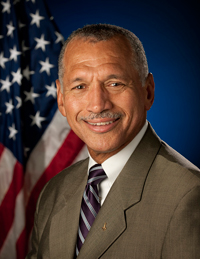
Download high resolution.
NASA Administrator Charles Bolden, National Space Trophy Presenter
(NASA Photo)
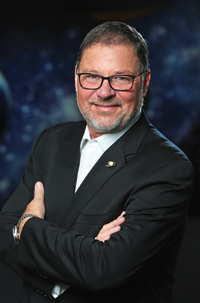
Download high resolution.
Elliot Pulham, Space Communicator Award Presenter
(Space Foundation Photo)

Download high resolution.
Miles O'Brien, Master of Ceremonies
(Miles O'Brien Photo)
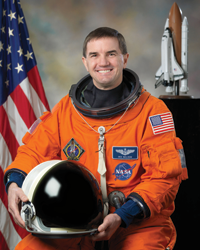
Download high resolution.
Astronaut Rex Walheim, Stellar Award Presenter
(NASA Photo)
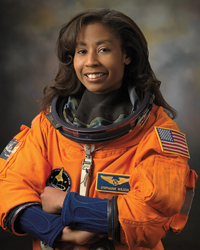
Download high resolution.
Astronaut Stephanie Wilson, Stellar Award Presenter
(NASA Photo)
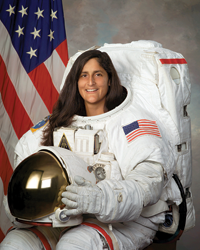
Download high resolution.
Astronaut Sunita Williams, Stellar Award Luncheon Speaker
(NASA Photo)
The RNASA Foundation was formed by the Space Center Rotary Club in 1985, to publicly recognize the heroes of America's space program. This year, the Foundation will present the 2016 National Space Trophy, to Dr. Charles Elachi, Director of NASA's Jet Propulsion Laboratory. NASA Administrator, The Honorable Charles F. Bolden, Jr., will present the prestigious award to Dr. Elachi who was nominated by A. Thomas Young, former Director of NASA's Goddard Space Flight Center. The National Space Trophy honoree is selected each year by the RNASA Foundation's Board of Advisors. This board represents a Who's Who of government and corporate aerospace leaders, including former trophy recipients.
RNASA welcomes back Miles O'Brien who will serve as Emcee of this special 30th anniversary event, and Gemini/Apollo Astronaut Lt. Gen. Thomas Stafford, USAF (Ret.), will present an OMEGA watch to Elachi at the closing of the program.
In addition to the National Space Trophy, the Foundation is awarding the Space Communicator award to Bill Nye, best known as "Bill Nye the Science Guy", a vocal advocate for space exploration, and CEO of The Planetary Society, the world's largest space-interest group. Nye's nominator, Elliot Pulham, CEO of the Space Foundation, and the 2003 Space Communicator winner, and will present the award.
The Foundation is pleased to have P.J. O'Rourke, journalist and American political satirist serving as the featured speaker at the gala. As a long-time advocate of the space industry, P.J. has serves on the Space Foundation Board of Directors and has been a returning speaker at the annual Space Symposium.
Finally, Stellar Awards will be presented to people in the industry, in early career, mid career, late career, and team categories. RNASA Chairman Rodolfo González said, "We received an impressive 137 stellar nominations this year, 43 government and 94 corporate." The nominations came from a.i. solutions, Inc., Aerojet Rocketdyne, Barrios Technology, The Boeing Company, Booz Allen Hamilton, ERC, Inc., GeoControl Systems, Jacobs, L-3 Communications, Lockheed Martin, NASA Ames Research Center, NASA Glenn Research Center, NASA Johnson Space Center, NASA Kennedy Space Center, NASA Marshall Space Flight Center, NASA Stennis Space Center, Oceaneering Space Systems, Orbital ATK, Pratt & Whitney, SAIC, SGT, SpaceX, United States Air Force, US Air Force Research Laboratory, UTC Aerospace Systems, and Wyle. For a complete list of the 2016 stellar nominees, visit www.rnasa.org/stellarnoms.html. Of all the nominations, only a few Stellar awards are given, and are announced the evening of the banquet. The winners will receive engraved marble trophies generously sponsored by Orbital ATK. The trophies will be presented by NASA Astronauts Rex Walheim and Stephanie Wilson.
The RNASA Stellar Awards Evaluation Panel ranks the nominations received from industry and government in all categories, based on whose accomplishments hold the greatest promise for furthering activities in space. The 2016 Stellar judges are Dr. Glynn S. Lunney, Arnold D. Aldrich, Colonel Eileen Collins, and Captain Michael Coats.
The Stellar Award nominees and team representatives will enjoy a behind-the-scenes tour of the Johnson Space Center and a luncheon where all are recognized with framed certificates and a Fisher Space Pen donated by the company. The Fisher Space Pen was originally carried by the astronauts of the Apollo moon missions and is still used on manned space flights to this day. They are precision assembled, hand tested, and guaranteed to perform underwater, at any angle including upside down, in extreme temperatures, and of course in zero gravity. The keynote speaker at the luncheon will be Captain Sunita Williams, who spent a record-breaking 194 days in space in 2007. The Stellar Awards Committee Chairman Jennifer Devolites, RNASA Foundation Chairman Rodolfo González, and Space Center Rotary Club President John Branch will also address the nominees at the Stellar Awards luncheon.
The reception begins at 6 p.m., and the program starts at 7 p.m. with a welcome by RNASA Chairman Rodolfo González. Following will be a presentation of the colors by Clear Lake High School Army JROTC, accompanied with the national anthem sung by the Reagan Johnson. Reverend William H. King, III, Lead Pastor, Greater New Hope Missionary Baptist Church will do the invocation. After dinner, the awards ceremony will kick off with a multimedia show summarizing the year's space events produced by Space City Films.
The RNASA Foundation invites members of the public and the aerospace community to attend the black-tie event. Individual tickets are $300, and corporate tables range from $2,000 to $5,000. Please use http://www.rnasa.org/tables.html to reserve your table for the RNASA Banquet, and for information about sponsorships and tickets. To reserve a hotel room, please use http://www.rnasa.org/houston.html at the Houston Hyatt Regency.
About RNASA: The Rotary National Award for Space Achievement (RNASA) Foundation was founded by the Space Center Rotary Club of Houston, Texas in 1985 to organize and coordinate an annual event to recognize outstanding achievements in space and create greater public awareness of the benefits of space exploration. The nonprofit Foundation presents the National Space Trophy and Stellar Awards each year.
Read the press release as a Word document.
Press Release
P.J. O'Rourke to serve as the 2016 RNASA featured speaker
Rotary National Award for Space Achievement
February 11, 2016
Media Contact: Lindsey Cousins, 281-723-5683, lindsey@baysidegraphics.net

See full size.
P.J. O'Rourke, journalist and American political satirist, will serve as the featured speaker at the 2016 RNASA awards banquet on April 29, 2016. (P.J. O'Rourke Photo)
Known for his humorous libertarian style, P.J. has authored 17 books including Don't Vote - It Just Encourages the Bastards and The Baby Boom: How It Got That Way (And It Wasn't My Fault) (And I'll Never Do It Again). Two of his titles, Give War a Chance and Parliament of Whores reached #1 on the New York Times Best Sellers list. In addition to his successful books, P.J. is a contributing editor at the Weekly Standard, a Cato Institute H.L. Mencken Fellow and a panelist on National Public Radio's game show Wait, Wait...Don't Tell Me!
As a long-time advocate of the space industry, P.J. has served on the Space Foundation Board of Directors since January 2012 and has been a returning speaker at the annual Space Symposium. "While P.J. is noted as the most quoted living humorist in the world, his support of space exploration is also a huge part of his passion for the things that make America great," said Elliot Pulham, Chief Executive Officer of the Space Foundation. "Through his writing, and his service as a board-level leader at the Space Foundation, P.J. O'Rourke helps the world to better understand why the exploration of space matters."
Regarding speaking at the RNASA Space Awards Gala, P.J. said "I'm a little daunted by the size of the audience. I've never before spoken to the entire universe. And I'm deeply honored."
P.J. began publishing freelance articles in magazines such as Rolling Stone, Vanity Fair and Car and Driver in 1981. He was the foreign affairs desk chief for Rolling Stone magazine until 2001, reporting on wars and riots, stories that were eventually compiled into the book Holidays in Hell.
Early is his career, P.J. served as editor-in-chief for National Lampoon. He received a writing credit for National Lampoon's Lemmings which helped Chevy Chase, John Belushi and Christopher Guest begin their successful careers in comedy. He also co-wrote National Lampoon's 1964 High School Yearbook, some of which was used in the 1978 movie Animal House.
Spanning more than 40 years, P.J.'s career happened remarkably by accident. He was quoted as saying "I began to write for pay in the spring of 1970. To tell the truth I didn't even mean to be a writer, I meant to be a race car driver, but I didn't have a race car." He was born in Toledo, Ohio where he completed his undergraduate studies at Miami University and earned a M.A. in English from Johns Hopkins University. P.J. and his wife Tina have three children, Elizabeth, Olivia and Clifford. They live in rural New Hampshire.
O'Rourke will be the featured speaker at RNASA's 30th annual National Space Trophy Banquet on April 29, 2016, at the Houston Hyatt Regency. Dr. Charles Elachi, Director of NASA's Jet Propulsion Laboratory, will receive the 2016 National Space Trophy. The award gala will be emceed by Miles O'Brien, science correspondent for PBS NewsHour
The RNASA Foundation invites members of the public and the aerospace community to attend the black-tie event on April 29, 2016, at the Houston Hyatt Regency. Please visit http://www.rnasa.org/tables.html to reserve your table for the RNASA Banquet and find information about sponsorships and tickets. To reserve a room at the Houston Hyatt Regency, please visit http://www.rnasa.org/houston.html or call 713-654-1234 and request the RNASA group rate. The RNASA website is http://www.rnasa.org/.
About RNASA: The Rotary National Award for Space Achievement (RNASA) Foundation was founded by the Space Center Rotary Club of Houston, Texas in 1985 to organize and coordinate an annual event to recognize outstanding achievements in space and create greater public awareness of the benefits of space exploration. The nonprofit Foundation presents the National Space Trophy and Stellar Awards each year.
Read the press release as a Word document.
2016 PRESS/PHOTO INFORMATION
Press Release
Bill Nye to receive RNASA's 2016 Space Communicator Award
Rotary National Award for Space Achievement
February 3, 2016
Media Contact: Lindsey Cousins, 281-723-5683, lindsey@baysidegraphics.net
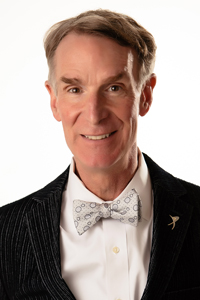
See full size.

See full size.
The Rotary National Award for Space Achievement (RNASA) Foundation has selected Bill Nye, scientist, engineer, comedian, author and inventor to receive the prestigious 2016 Space Communicator Award. Nye has helped increase public support for space exploration through activities and outreach in his role as CEO of the Planetary Society. (Planetary Society Photos)
A vocal advocate for space exploration, Nye is also the CEO of The Planetary Society, the world's largest space-interest group. Nye is being honored by RNASA for his passion and talent to engage and educate audiences on the benefits of space exploration and the discoveries that result. Under his leadership since 2010, the non-profit organization has seen an increase in membership and donations, allowing it to expand its efforts to advocate and educate, as well as fund exploration projects and citizen science activities.
Elliot Pulham, Chief Executive Officer of the Space Foundation who nominated Bill Nye said, "It is my honor to nominate Bill Nye 'The Science Guy' for the RNASA 2016 Space Communicator Award, for inspiring a new generation of space and science professionals, and tireless advocacy of space exploration and science literacy."
Nye said, "Space exploration brings out the best in us, it's an honor to receive this award. I plan to continue my work advancing science literacy and space exploration, so that people everywhere can know the cosmos and our place in it."
Nye is a man with a mission: to help foster a scientifically literate society, to help people everywhere understand and appreciate the science that makes our world work. Making science entertaining and accessible is something Nye has been doing most of his life.
Nye's fascination with how bicycles, airplanes and other things work led him to Cornell University and a degree in Mechanical Engineering in 1977. Soon after graduating, Boeing recruited him as an engineer in Seattle, Washington. It was in Seattle that Nye began to combine his love of science with his flair for comedy. Eventually, Nye quit his engineering day job and made the transition to a night job as a comedy writer and performer on Seattle's homegrown ensemble comedy show "Almost Live" in 1986.
It was there "Bill Nye the Science Guy®" was born, as a six-minute segment highlighting science. The popularity of the segments led to the educational television series that ran from 1993 to 1998.
While working on the Science Guy show, Nye won seven national Emmy Awards for writing, performing, and producing. The show won 18 Emmys in five years. In between creating the shows, he wrote five kids' books about science: "Big Blast of Science", "Bill Nye's Consider the Following", "Bill Nye The Science Guy's Big Blue Ocean", "Bill Nye The Science Guy's Great Big Dinosaur Dig" and "Bill Nye The Science Guy's Great Big Book of Tiny Germs."
Nye's first book for a general audience, "Undeniable — Evolution and the Science of Creation," was featured on the New York Times' Bestsellers List. Nye's most recent book, "Unstoppable — Harnessing Science to Change the World," takes on the subjects of energy and climate change.
The RNASA Space Communicator Award was created in 1997 in honor of KTRK, Houston Channel 13 space reporter and long-time RNASA Advisor Stephen Gauvain who was tragically killed in a car accident in 1996. The Award is presented to an individual or team that makes exceptional contributions to public understanding and appreciation of space exploration. Previous recipients include: William Harwood of CBS; Miles O'Brien, formerly of CNN; Elliot Pulham of the Space Foundation; the NASA-Contractor Communications team that responded to the Columbia accident; Mark Carreau, formerly of the Houston Chronicle; Neil deGrasse Tyson of the Hayden Planetarium at the American Museum of Natural History in New York City, Veronica McGregor, Manager of News and Social Media at NASA's Jet Propulsion Laboratory in Pasadena, California, and former Canadian Space Agency astronaut, author, and musician Chris A. Hadfield.
Nye will be honored with the 2016 Space Communicator Award at RNASA's 30th annual National Space Trophy Banquet on April 29, 2016, at the Houston Hyatt Regency. Dr. Charles Elachi, Director of NASA's Jet Propulsion Laboratory, will receive the 2016 National Space Trophy. The award gala will be emceed by Miles O'Brien, science correspondent for PBS NewsHour, Author and satirist P.J. O'Rourke will be a featured speaker.
The RNASA Foundation invites members of the public and the aerospace community to attend the black-tie event on April 29, 2016, at the Houston Hyatt Regency. Please visit http://www.rnasa.org/tables.html to reserve your table for the RNASA Banquet and find information about sponsorships and tickets. To reserve a room at the Houston Hyatt Regency, please visit http://www.rnasa.org/houston.html or call 713-654-1234 and request the RNASA group rate. The RNASA website is http://www.rnasa.org/.
About RNASA: The Rotary National Award for Space Achievement (RNASA) Foundation was founded by the Space Center Rotary Club of Houston, Texas in 1985 to organize and coordinate an annual event to recognize outstanding achievements in space and create greater public awareness of the benefits of space exploration. The nonprofit Foundation presents the National Space Trophy and Stellar Awards each year.
Read the press release as a Word document.
Press Release
Dr. Charles Elachi, Director of NASA's Jet Propulsion Laboratory, to Receive the 2016 National Space Trophy
Rotary National Award for Space Achievement
January 19, 2016
Media Contact: Lindsey Cousins, 281-723-5683, lindsey@baysidegraphics.net
Rodolfo Gonzalez, President of the RNASA Foundation said, "The Foundation is very pleased with the board of advisors' selection of Dr. Elachi and is looking forward to recognizing him as the guest of honor at the RNASA Space Awards Gala."
Dr. Elachi was nominated for the award by A. Thomas Young, former Director of NASA's Goddard Space Flight Center. Young said, "Charles Elachi's distinguished leadership and sustained technical achievement has had a profound impact on the U.S. robotic exploration of space across the late 20th and early 21st centuries... His contributions and vision have impacted space science and technology, generations of young people and professionals, and society at large."
Dr. Elachi said, "I'm honored to receive the National Space Trophy from this prestigious organization. I feel so fortunate to be involved in space exploration during an extremely exciting time, when we are rewriting science books, fulfilling humanity's innate quest for discovery, and bringing tangible technology and science advances back to Earth. I am grateful for the invaluable contributions of the teams of dedicated and immensely talented men and woman I've worked with through the years."
Dr. Elachi is credited with pioneering the use of radar remote sensing techniques, overseeing missions such as the Shuttle Imaging Radar series, the Magellan Imaging Radar at Venus and the Cassini Titan Radar currently studying Saturn's moon Titan.
Young describes the 15 years that Dr. Elachi has been director of Jet Propulsion Laboratory as an "exceptionally productive" time in which Dr. Elachi has led the development and operation of robotic spacecraft systems that have studied Earth, the solar system, and deep space.
The study of Earth has included a satellite mission that used advanced radar to study the inner structure of clouds, as well as missions and instruments that have studied the oceans, Earth's gravity field, air pollutants, global temperatures and greenhouse gases. These efforts have contributed enormously to our understanding of weather and climate, including climate change. They include Cloudsat, Jason-1 and Jason-2, the Gravity Recovery and Climate Experiment (GRACE), the Tropospheric Emission Spectrometer (TES), the Microwave Limb Sounder (MLS) and the Atmospheric Infrared Sounder (AIRS) instruments.
Study of Earth's moon has included the study of its interior structure by the twin Gravity Recovery and Interior Laboratory (GRAIL) orbiters, the study of surface temperatures by the Diviner instrument and the Moon Mineralogy Mapper. Further into space is the robotic exploration of Mars with the Curiosity rover, the Mars Phoenix Lander, the Spirit and Opportunity rovers, the Mars Reconnaissance Orbiter and the Mars Odyssey 2001. Opportunity, originally planned as a three-month mission, is celebrating its 12-year anniversary this month.
Multiple space missions are exploring other parts of the solar system. The Cassini spacecraft has spent more than a decade exploring Saturn, its rings and its moons, and its intriguing discoveries have included evidence of an ocean on Enceladus and lakes on Titan. Dr. Elachi leads the Cassini radar team. The Dawn spacecraft has used ion propulsion to orbit two bodies in succession: first, the giant asteroid Vesta, and currently, the dwarf planet Ceres. The Genesis mission captured and returned to Earth samples of solar wind ejected from the sun.
Comets have been the focus of several missions during Dr. Elachi's tenure. Deep Impact deliberately collided with comet Tempel 1 so scientists could study the comet's interior, and the craft later flew by comet Hartley 2. Stardust became the first mission to return material from beyond the orbit of Earth's moon, when it brought back dust samples from its flyby of comet Wild-2. JPL provided the MIRO instrument for the European Space Agency's Rosetta orbiter, which deployed a lander to the surface of a comet.
The Juno spacecraft was launched in 2011 and will arrive at Jupiter on the Fourth of July in 2016 to study its interior. The Voyager I spacecraft reached interstellar space in 2012, and Voyager II is not far behind. They continue to operate 35 years after launch.
Telescopes looking at the universe include the Spitzer Space Telescope, the Wide-Field Infrared Survey Explorer (WISE), the Kepler Space Telescope, which has confirmed 1,030 planets to date, the Nuclear Spectroscopic Telescope Array (NuSTAR) and the Galaxy Evolution Explorer. These have studied the universe in infrared, high energy x-rays, and ultraviolet. They have mapped the sky and studied comets, asteroids, planets, stars and galaxies, telling us about star formation, galaxy formation, the early universe, black holes and so much more. Other missions and instruments have studied the sun, solar wind material and cosmic background radiation in far infrared and millimeter wavelengths.
Beyond space, Dr. Elachi's contributions include teaching the physics of remote sensing for two decades at the California Institute of Technology. As a research scientist, he has authored more than 200 publications in the fields of active microwave remote sensing, wave propagation and scattering, electromagnetic theory, lasers and integrated optics.
He has been a member of the National Academy of Engineering since 1989 and has received numerous awards and medals, both in the United States and internationally. These include the NASA Exceptional Scientific Achievement Medal and Outstanding Leadership Medal, the COSPAR Nordberg Medal, the German Wernher Von Braun Award, the Nevada Medal, and the Dryden Medal. The Takeda Foundation of Japan awarded him its medal for his work in developing space radar instruments to monitor the global environment. He also has an asteroid named after him: 4116 Elachi. In 2007, U.S. News and World Report named Dr. Elachi one of America's Best Leaders.
The RNASA Foundation invites members of the public and the aerospace community to attend the black-tie event on April 29, 2016, at the Houston Hyatt Regency, where Dr. Charles Elachi will be recognized with the National Space Trophy. This year will be RNASA's 30th annual National Space Trophy Banquet. Please visit http://www.rnasa.org/tables.html to reserve your table for the RNASA Banquet and find information about sponsorships and tickets. To reserve a room at the Houston Hyatt Regency, please visit http://www.rnasa.org/houston.html or call 713-654-1234 and request the RNASA group rate.
About RNASA: The Rotary National Award for Space Achievement (RNASA) Foundation was founded by the Space Center Rotary Club of Houston, Texas, in 1985 to organize and coordinate an annual event to recognize outstanding achievements in space and create greater public awareness of the benefits of space exploration. The nonprofit Foundation presents the National Space Trophy and Stellar Awards each year. The RNASA website is http://www.rnasa.org/.
Read the press release as a Word document.

